This spring I’ve helped out with a couple plant surveys organized by the local CNPS chapter. There are plenty of plants in the county and relatively few people to survey them, so the chapter picks a plant or group of plants for which there’s a compelling need to inventory them. The theme this year was dune plants. I don’t know this group of plants very well, so it’s been a great learning experience.
Surveys in two locations netted five or six rare List 1B species. (See the CNPS definition of the various listings [ here ].) I was there for four to five of them.
At the first location it was hard to miss the rare form of Juncus acutus, towering over my head. Shown here, it’s surrounded by the common but wonderfully perky yellow beach evening primrose (Camissonia cheiranthifolia) and the exotic sea rocket, Cakile maritima.
(A closeup of the dune evening primrose.)
Also nearby, also yellow, common, and perky: telegraph weed, Heteroteca grandiflora.
But enough of these common plants. We came here looking for rare ones!
Here’s one that was pretty hard to miss: Nuttall’s lotus, Lotus nuttallianus. I hope you like yellow. The bright flowers turn orange-red after they’ve been pollinated, encouraging the pollinators to visit the still-not-deflowered yellow blooms.
This snowy plover and least tern preserve was one of the plants’ favored areas. The word “preserve” promised more than was evident here. It was a patch of sand like any other part of the beach, but with just one piece of white string around it. Any dog or small child or group of teens with a cooler could have stepped inside, squashing the plants, scrambling the eggs and nestlings.
We saw several hundred of these, Brand’s phacelia, Phacelia stellaris. Around the edges of this patch you can see the one of invasive species of Erodium.
Another look at the phacelia… Most were about this size, practically belly flowers. But occasionally–as in the semi-shade beneath a picnic bench–you’d find individuals almost a foot tall.
And the last of the rare plants we surveyed the first day, coast wooly-heads, Nemacaulis denudata var. denudata. There were thousands at the first site. They weren’t flowering yet, but the plants were unmistakable with their long accordion-pleated white leaves. In bloom, they’ll have wiry stems floating little creamy balls of bloom over the leaves.
Here’s a final shot, a closeup of the flowering heads of the Juncus acutus. ssp. leopoldii.
It’s a stunning plant out on the sand. And of all of these, the common form of Juncus acutus is something you’ll see offered in various native plant catalogs. If you need a big, architectural, spiky sedge that likes a certain amount of moisture, this might be just your plant.

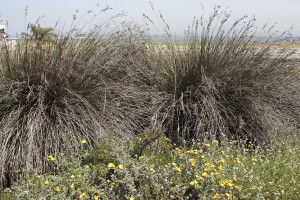
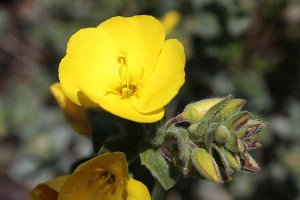

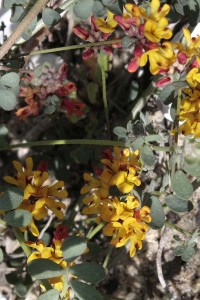
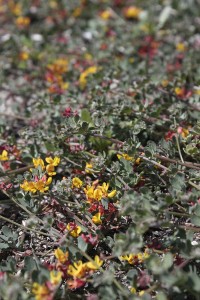
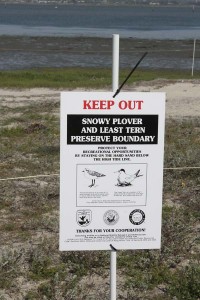
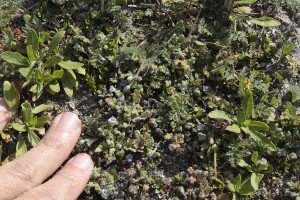
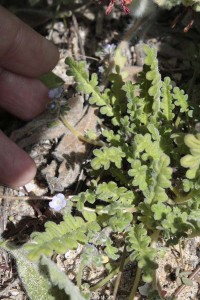


How exciting to find so many rare species in one survey! The Nuttall’s Lotus is beautiful with the splashes of red-orange. I mostly see Lotus purshianus here.
The beach areas, like the deserts have low key ‘invisible’ plants sometimes. We see the ocean and that takes our attention, but looking down you can see all kinds of diverse plant treasures, as you have done here. Taking part in this survey sounds like it was a great opportunity!
I’d like the Nemacaulis. Is it garden worthy? Easy for you to grow?
Oh, I’d love to be involved with something like this! I confess, I know nothing about your native plants but it would certainly be fun to learn. 🙂
What an interesting activity to take part! My state (GA) has given my part of the world to Florida’s native plant society because our plants are more like Florida than like Georgia’s metro Atlanta area.
Curbstone Valley, what was really fun is that the rare plants were more common in some spots than a lot of what I’d consider the more generally common plants. But though locally common, they’re definitely rare once you start moving away from where we found them.
Sue, it was so much fun I’m going on another little one tomorrow. The discovery part is fun, the part about counting the plants can get challenging when you have large populations and spend all day looking straight down. It’s harder work than I thought it’d be!
EE, I haven’t tried the Nemacaulis, and I don’t think it’s in the horticultural trade. It flowers, yes, but the blooms won’t win it any awards. But I could see growing it for its terrific foliage.
Kate, I’m always confronted with how few plants I know well when I go out on one of these trips. And each location seems to have its own interesting mix of species.
Nell Jean, plants don’t pay much attention to state boundaries, do they? Here in California it’s impossible to outline a typical climate profile. In my county alone we have many cities with less than Phoenix, as well as a few other cities with as much rain as Seattle.
Phacelia on the beach? Perchance the next custom cocktail at the ‘W’ in San Diego…All kidding aside, I’m really surprised that there are phacelias growing in dune habitat. I’m sure that’s why they’re CNPS listed as rare.
I had no idea dunes could be so full of wonderful flora, so thank you for a very educational post! Glad I’ve finally got around to catching up on blogs – of course if you added a “subscribe by email” option it would be easier to keep up to date 😉
las plantas tienen mucha importancia en el mundo y estas en particular son muy extrabagantes y posiblemente tengan alguna propiedad natural curativa